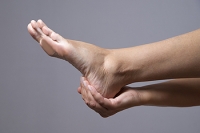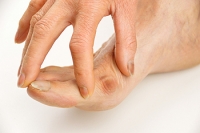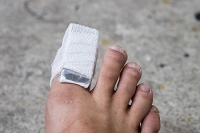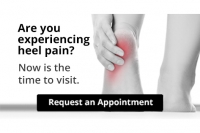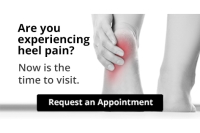
Blog (822)
All About Plantar Fasciitis
Plantar fasciitis affects more than three million people each year. This ailment typically occurs when the foot’s shock absorbing ligament, also known as the plantar fascia, suffers inflammation or small tears from too much tension or stress. The ligament associated with plantar fasciitis runs across the entire bottom of the foot. However, the pain associated with this condition is usually only located within the center of the heel. Some people do tend to experience pain up into their arch, though. Plantar fasciitis can be caused by a variety of occurrences such as jobs that keep people on their feet, stressful exercises, obesity, or wearing shoes with little support. Treatments for plantar fasciitis may include icing your feet, receiving cortisone injections, wearing a specialized boot, and even doing stretches. If you are experiencing any foot pain, an appointment with your podiatrist is highly advised.
Plantar fasciitis can be very painful and inconvenient. If you are experiencing heel pain or symptoms of plantar fasciitis, contact Dr. Kenneth Donovan from Advanced Care Foot and Ankle. Our doctor can provide the care you need to keep you pain-free and on your feet.
What Is Plantar Fasciitis?
Plantar fasciitis is the inflammation of the thick band of tissue that runs along the bottom of your foot, known as the plantar fascia, and causes mild to severe heel pain.
What Causes Plantar Fasciitis?
- Excessive running
- Non-supportive shoes
- Overpronation
- Repeated stretching and tearing of the plantar fascia
How Can It Be Treated?
- Conservative measures – anti-inflammatories, ice packs, stretching exercises, physical therapy, orthotic devices
- Shockwave therapy – sound waves are sent to the affected area to facilitate healing and are usually used for chronic cases of plantar fasciitis
- Surgery – usually only used as a last resort when all else fails. The plantar fascia can be surgically detached from the heel
While very treatable, plantar fasciitis is definitely not something that should be ignored. Especially in severe cases, speaking to your doctor right away is highly recommended to avoid complications and severe heel pain. Your podiatrist can work with you to provide the appropriate treatment options tailored to your condition.
If you have any questions please feel free to contact one of our offices located in Warren, Livingston, and Toms River, NJ . We offer the newest diagnostic and treatment technologies for all your foot and ankle needs.
It’s Time for Beautiful Feet
It's Time for Beautiful Feet
What is a Bunion?
A large growth located on the foot at the bottom of the big toe is referred to as a bunion. It appears as an unsightly bony mass and may be caused by a predisposed inherited trait.
Wearing high heels may cause the toes to remain in a cramped position for extended periods of time, and this can exacerbate an existing bunion. There are several ways to prevent this condition from occurring, including wearing shoes with a low heel or making sure a supportive feature, such as a strap, is present to prevent the foot from sliding. Additionally, it’s important to wear shoes with ample room to allow the toes to move freely. If you’re experiencing a bunion that’s causing severe pain, a consultation with a podiatrist is advised for possible treatment options.
If you are suffering from bunions, contact Dr. Kenneth Donovan of Advanced Care Foot and Ankle. Our doctor can provide the care you need to keep you pain-free and on your feet.
What Is a Bunion?
A bunion is formed of swollen tissue or an enlargement of boney growth, usually located at the base joint of the toe that connects to the foot. The swelling occurs due to the bones in the big toe shifting inward, which impacts the other toes of the foot. This causes the area around the base of the big toe to become inflamed and painful.
Why Do Bunions Form?
Genetics – Susceptibility to bunions are often hereditary
Stress on the feet – Poorly fitted and uncomfortable footwear that places stress on feet, such as heels, can worsen existing bunions
How Are Bunions Diagnosed?
Doctors often perform two tests – blood tests and x-rays – when trying to diagnose bunions, especially in the early stages of development. Blood tests help determine if the foot pain is being caused by something else, such as arthritis, while x-rays provide a clear picture of your bone structure to your doctor.
How Are Bunions Treated?
- Refrain from wearing heels or similar shoes that cause discomfort
- Select wider shoes that can provide more comfort and reduce pain
- Anti-inflammatory and pain management drugs
- Orthotics or foot inserts
- Surgery
If you have any questions, please feel free to contact one of our offices located in Warren, Livingston, and Toms River, NJ. We offer the newest diagnostic and treatment technologies for all your foot care needs.
What is a Bunion?
 A large growth located on the foot at the bottom of the big toe is referred to as a bunion. It appears as an unsightly bony mass and may be caused by a predisposed inherited trait. Wearing high heels may cause the toes to remain in a cramped position for extended periods of time, and this can exacerbate an existing bunion. There are several ways to prevent this condition from occurring, including wearing shoes with a low heel or making sure a supportive feature, such as a strap, is present to prevent the foot from sliding. Additionally, it’s important to wear shoes with ample room to allow the toes to move freely. If you’re experiencing a bunion that’s causing severe pain, a consultation with a podiatrist is advised for possible treatment options.
A large growth located on the foot at the bottom of the big toe is referred to as a bunion. It appears as an unsightly bony mass and may be caused by a predisposed inherited trait. Wearing high heels may cause the toes to remain in a cramped position for extended periods of time, and this can exacerbate an existing bunion. There are several ways to prevent this condition from occurring, including wearing shoes with a low heel or making sure a supportive feature, such as a strap, is present to prevent the foot from sliding. Additionally, it’s important to wear shoes with ample room to allow the toes to move freely. If you’re experiencing a bunion that’s causing severe pain, a consultation with a podiatrist is advised for possible treatment options.
If you are suffering from bunions, contact Dr. Kenneth Donovan of Advanced Care Foot and Ankle. Our doctor can provide the care you need to keep you pain-free and on your feet.
What Is a Bunion?
A bunion is formed of swollen tissue or an enlargement of boney growth, usually located at the base joint of the toe that connects to the foot. The swelling occurs due to the bones in the big toe shifting inward, which impacts the other toes of the foot. This causes the area around the base of the big toe to become inflamed and painful.
Why Do Bunions Form?
Genetics – Susceptibility to bunions are often hereditary
Stress on the feet – Poorly fitted and uncomfortable footwear that places stress on feet, such as heels, can worsen existing bunions
How Are Bunions Diagnosed?
Doctors often perform two tests – blood tests and x-rays – when trying to diagnose bunions, especially in the early stages of development. Blood tests help determine if the foot pain is being caused by something else, such as arthritis, while x-rays provide a clear picture of your bone structure to your doctor.
How Are Bunions Treated?
- Refrain from wearing heels or similar shoes that cause discomfort
- Select wider shoes that can provide more comfort and reduce pain
- Anti-inflammatory and pain management drugs
- Orthotics or foot inserts
- Surgery
If you have any questions, please feel free to contact one of our offices located in Warren, Livingston, and Toms River, NJ . We offer the newest diagnostic and treatment technologies for all your foot care needs.
Symptoms of a Broken Toe
Severe pain is likely to be experienced if you have a broken toe, and it will typically heal within 6 weeks. The toe may be tender, bruised, and swollen, often resulting in difficulty in walking. The treatment for a broken or bruised toe is the same, despite the fact that many people have trouble differentiating between the two. Temporary relief may come from elevating the foot, which generally helps in reducing any pain or swelling associated with this condition. Additionally, choosing to wear shoes that give the toes ample room to move may aid in diminishing any discomfort that may be experienced. If the toe is bent at an unnatural angle indicating a severe break, a consultation with a podiatrist is suggested for ways to properly treat your broken toe.
A broken toe can be very painful and lead to complications if not properly fixed. If you have any concerns about your feet, contact Dr. Kenneth Donovan from Advanced Care Foot and Ankle. Our doctor will treat your foot and ankle needs.
What to Know About a Broken Toe
Although most people try to avoid foot trauma such as banging, stubbing, or dropping heavy objects on their feet, the unfortunate fact is that it is a common occurrence. Given the fact that toes are positioned in front of the feet, they typically sustain the brunt of such trauma. When trauma occurs to a toe, the result can be a painful break (fracture).
Symptoms of a Broken Toe
- Throbbing pain
- Swelling
- Bruising on the skin and toenail
- The inability to move the toe
- Toe appears crooked or disfigured
- Tingling or numbness in the toe
Generally, it is best to stay off of the injured toe with the affected foot elevated.
Severe toe fractures may be treated with a splint, cast, and in some cases, minor surgery. Due to its position and the pressure it endures with daily activity, future complications can occur if the big toe is not properly treated.
If you have any questions please feel free to contact one of our offices located in Warren, Livingston, and Toms River, NJ. We offer the newest diagnostic and treatment technologies for all your foot and ankle needs.
What is Sesamoiditis?
The tendons attached to the bones located on the sole of the foot are referred to as the sesamoid bones. If these tendons become inflamed, typically resulting from an injury, a condition known as sesamoiditis occurs. A common symptom is pain experienced under the ball of the foot while walking, or discomfort may be felt from standing on your toes because the tendons are stretched. Choosing to wear high heels in addition to participating in sports that involve running and jumping may be common causes of this condition. Treatment may include ceasing the activity that caused sesamoiditis and considering a consultation with a podiatrist for custom-made insoles to provide relief.
Sesamoiditis is an unpleasant foot condition characterized by pain in the balls of the feet. If you think you’re struggling with sesamoiditis, contact Dr. Kenneth Donovan of Advanced Care Foot and Ankle. Our doctor will treat your condition thoroughly and effectively.
Sesamoiditis
Sesamoiditis is a condition of the foot that affects the ball of the foot. It is more common in younger people than it is in older people. It can also occur with people who have begun a new exercise program, since their bodies are adjusting to the new physical regimen. Pain may also be caused by the inflammation of tendons surrounding the bones. It is important to seek treatment in its early stages because if you ignore the pain, this condition can lead to more serious problems such as severe irritation and bone fractures.
Causes of Sesamoiditis
- Sudden increase in activity
- Increase in physically strenuous movement without a proper warm up or build up
- Foot structure: those who have smaller, bonier feet or those with a high arch may be more susceptible
Treatment for sesamoiditis is non-invasive and simple. Doctors may recommend a strict rest period where the patient forgoes most physical activity. This will help give the patient time to heal their feet through limited activity. For serious cases, it is best to speak with your doctor to determine a treatment option that will help your specific needs.
If you have any questions please feel free to contact one of our offices located in Warren, Livingston, and Toms River, NJ. We offer the newest diagnostic and treatment technologies for all your foot and ankle needs.
What is Sesamoiditis?
 The tendons attached to the bones located on the sole of the foot are referred to as the sesamoid bones. If these tendons become inflamed, typically resulting from an injury, a condition known as sesamoiditis occurs. A common symptom is pain experienced under the ball of the foot while walking, or discomfort may be felt from standing on your toes because the tendons are stretched. Choosing to wear high heels in addition to participating in sports that involve running and jumping may be common causes of this condition. Treatment may include ceasing the activity that caused sesamoiditis and considering a consultation with a podiatrist for custom-made insoles to provide relief.
The tendons attached to the bones located on the sole of the foot are referred to as the sesamoid bones. If these tendons become inflamed, typically resulting from an injury, a condition known as sesamoiditis occurs. A common symptom is pain experienced under the ball of the foot while walking, or discomfort may be felt from standing on your toes because the tendons are stretched. Choosing to wear high heels in addition to participating in sports that involve running and jumping may be common causes of this condition. Treatment may include ceasing the activity that caused sesamoiditis and considering a consultation with a podiatrist for custom-made insoles to provide relief.
Sesamoiditis is an unpleasant foot condition characterized by pain in the balls of the feet. If you think you’re struggling with sesamoiditis, contact Dr. Kenneth Donovan of Advanced Care Foot and Ankle. Our doctor will treat your condition thoroughly and effectively.
Sesamoiditis
Sesamoiditis is a condition of the foot that affects the ball of the foot. It is more common in younger people than it is in older people. It can also occur with people who have begun a new exercise program, since their bodies are adjusting to the new physical regimen. Pain may also be caused by the inflammation of tendons surrounding the bones. It is important to seek treatment in its early stages because if you ignore the pain, this condition can lead to more serious problems such as severe irritation and bone fractures.
Causes of Sesamoiditis
- Sudden increase in activity
- Increase in physically strenuous movement without a proper warm up or build up
- Foot structure: those who have smaller, bonier feet or those with a high arch may be more susceptible
Treatment for sesamoiditis is non-invasive and simple. Doctors may recommend a strict rest period where the patient forgoes most physical activity. This will help give the patient time to heal their feet through limited activity. For serious cases, it is best to speak with your doctor to determine a treatment option that will help your specific needs.
If you have any questions please feel free to contact one of our offices located in Warren, Livingston, and Toms River, NJ . We offer the newest diagnostic and treatment technologies for all your foot and ankle needs.
